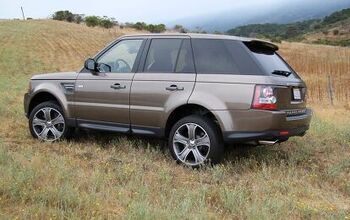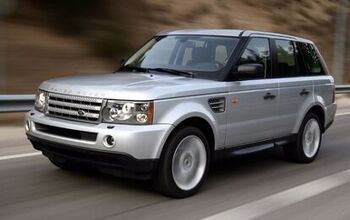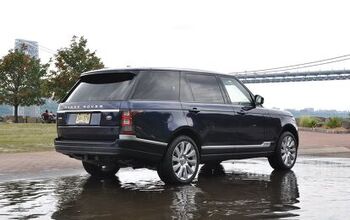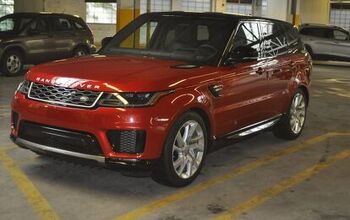Review: 2011 Range Rover HSE and Supercharged

If you are on the market for a classically-styled English luxury vehicle with a compliant ride and a sticker under a quarter-million dollars, the Range Rover dealer might be your only destination. After all, Jaguar recently nixed the styling often referred to as “fussy” (but I preferred to think of as “dignified”) opting instead for jamming insane engines into sporty, avant-garde styled rides, Bentley has been churning out stiffly sprung modern sports cars lately leaving only the dueling RRs, Range Rover and Rolls Royce, to battle for our softly sprung anglophile hearts and minds. (Mind you, the baby Roller is considerably more expensive than anything coming out of Solihull.) With this kind of company, does a Rover have what it takes to be the ultimate in off-road luxury? Or will it at least make a more appropriate garage mate than a Jeep?
For the uninitiated, Range Rover is not quite a brand per se, it’s a model; Land Rover is the brand. Making this more confusing is the proliferation of the Range Rover name in products such as the Range Rover Sport and the Range Rover Evoque. The “real” Range Rover, known only as a “Range Rover” was completely redesigned in 2002 taking the sub-brand considerably upmarket. TTAC took a spin back in 2004 and over the past seven years the Range Rover has been tweaked and primped regularly to keep the vehicle fresh and keep the MSRP on a steady upward climb. 2010’s update was a bit more than the usual mid-cycle refresh and brought new interior parts, new infotainment systems, updated styling and most importantly: completely new drivetrains.
Before we dive into the “real” Range Rover, we should cover what the Range Rover is and what it isn’t. Despite looking quite similar to the Range Rover Sport, the Range Rover shares almost nothing with the plebian model aside from the engine, transmission and radio. The Range Rover Sport is based on the Ford-designed Land Rover LR4 with some Volvo bits tossed in. The “real” Range Rover was originally designed under BMW ownership and uses BMW parts-bin bits. Confused yet?
As the Range Rover Supercharged press loaner pulled up [Ed: please note that images are all of the Supercharged due to an unfortunate camera theft], I almost expected either Jay-Z or The Queen emerge. I realize these two icons could not possibly be farther apart, but somehow both are attracted to the unmistakable styling of the Range Rover. In certain circles, having a Range Rover is the ultimate bling. In other circles a Range Rover is a sign of restrained elegance and country estate ownership. This dichotomy was not lost on us. Either way you swing, the slab-sided Range Rover checks all the right boxes: far from brash like a BMW X5M, better proportioned than a Porsche Cayenne Turbo and it won’t make you feel like you are fighting an urban war in the middle-east like a Mercedes G-class. Yet, it is with this (perhaps unlikely) trio of Germans the English off-roader naturally plays. The Lexus LX570 represents something too ordinary being a Toyota Land Cruiser in a nice suit (and it is too cheap anyway). In that same way the X5, GL and Cayenne might even be entirely dismissed by shoppers as they are merely social climbing members of a more plebian origin.
In order to get a sense of the price range of the Range Rover, we first spent a week in the almost-base-model Range Rover HSE Lux before spending another week in a middle-of-the-range Range Rover Supercharged. Our “bargain priced” tester arrived with a most English interior: ivory leather and more dark brown piping than a plumbing wholesaler. This is the interior you are used to in a British vehicle of any type; elegant but restrained, luxurious but not gaudy and just the perfect amount of pretentiousness.
High society often prefers to avoid price discussions, but let’s dive in anyway. Price is truly what separates the Range Rover from the rest of the Land Rover’s creations. The Range Rover in base HSE trim starts at $79,685. (This means the base Range Rover is only a fee Benjamins cheaper than the most expensive Range Rover Sport model.)
Stepping up from the Range Rover HSE model to the HSE Lux trim gets your hind end some cooled seats, more wood, better cow and a few other goodies from $84,285. The Supercharged trim (the tester we had for week two) adds an insane 510HP supercharged V8, six-piston front brakes with ginormous rotors, air suspension with dynamic damping, and access to even more options. If six-digits don’t scare you, the Range Rover Autobiography covers everything including the ceiling in cowhide, possesses a snazzier color palette, yet more standard goodies and a price tag to match starting at an eye-bulging $116,000 and easily cresting $134,000. Decided your AWD Bentley lacks the ground clearance required for your country estate? No problem, the Range Rover Autobiography Black Limited Edition is the SUV for you but you’d better have deep pocket; admission starts at $122,950 and ends up god-knows-where after options.
From the soft leather thrones to the stitched leather dashboard and abundant wood trim to the optional stitched leather headliner it’s obvious some serious time was spent on the details. Need more proof the Range Rover is not your ordinary luxury car? Only the English would charge you $350 more to fit your SUV with wood that is lacquered so black it looks like plastic. While this may seem stupid to some of us, it allows Range Rover owners to tell passengers: “see that, that’s real wood that top-quality labor in the UK hand lacquered to look like plastic.”
Tall thrones and vast expanses of glass make it easy to see and be seen while on or off the road, and an electric grid in the front windscreen makes sure it is clear in any kind of weather. If your Range Rover is destined to be driven for you, four-zone climate control and heated/cooled/reclining rear seats are available just like any full-size luxury sedan. Just tell Jeeves to take it easy on the tank-traps. Despite the larger and boxier proportions vs the Range Rover Sport, cargo room checks in only a hair larger at 35.2 cu-ft with the seats upright and 74.2 folded. While this is perfectly sufficient for a weekend getaway for four, it’s not much bigger than your average mid-size SUV.
Much like Jaguars of yore, Range Rover luxuries focus on price, style and feel rather than gizmos. This means while there are a few nifty-whiz-bang gadgets, electronic doo-dad lovers are best advised to shop further down the food chain. This proved to be a problem for me as I “love me some gadgets.” The first thing that bugged me was the lack of smart-key entry made doubly infuriating because keyless-ignition is standard. This means half the equipment is already present but they didn’t go the distance. Worse yet, the cheaper Range Rover Sport gets smart-key entry standard. Looking beyond this glaring omission you’ll find all the usual optional goodies to please a luxury car owner including a surround camera system, blind spot monitoring, surround audio, radar cruise control, automatic high beams, rear seat entertainment, and a heated steering wheel. Don’t expect heads-up displays, night vision systems, lane keeping systems or shiatsu massages, if you want that sort of thing you’ll need to stay on-road and in something else.
The Logic 7 sound systems (available in a 14 speaker/720 watt or 19 speaker/1,200 watt version) produce extremely well-balanced audio for both front and rear passengers. Regardless of the audio system selected, control of your tunes and navigation is handled by the sluggish 7-inch touch screen display in the center of the dash. While the system’s features are fairly standard, graphics are pleasing and the functionality is high; the response of the system is slow enough to drive you crazy while attempting to navigate the menus. In another odd twist, Land Rover no longer includes the cable to connect your iPhone/iPod to the proprietary interface connector in the center console leaving high-roiling buyers to snag it as an accessory at the dealer for a bundle. My local dealer was none too pleased with the new cable arrangement as buyers have apparently been very vocal about it. On the bright side, the revised rear seat entertainment system now comes with a snazzy touch-screen remote control which befits the price tag, something that cannot be said of most systems in this price range.
Press the start button on the dash and the gorgeous 12.3-inch LCD gauge cluster comes to life. This is essentially the same LCD used in the new Jaguar XJ, and like the XJ, it replaces all the traditional gauges in the vehicle. The display is bright and readable in almost all lighting conditions, the blacks look black, the response time is lightning fast and the graphics are top-notch. Sadly however, the gauge cluster offers little customization and does not offer the duplicate nav-screen feature the XJ does (pops a small nav map in place of the tach). It does however duplicate the 4×4 system information provided on the navigation screen which could be handy if you ever took your expensive three-ton baby off the beaten path. I really hope next year brings an update to the nuveau disco-dash so it can be a bit more useful. It would be nice if it would at least display track info from your iPod or radio.
If you’ve read my review of the Range Rover Sport, I came to the decision that it might just be the ultimate man-wagon. It’s the Sport’s combination of butch looks, insane power and decent on-road feel that drew me to that conclusion. The full-on Range Rover’s road manners however can best be described as a three-ton marshmallow. It’s that comparison back to the Sport that plagued me all thru my time with the Range Rover. The Sport sacrifices only a modicum of off-road prowess for improved road manners, the Range Rover on the other hand makes few such compromises. Taking the Range Rover into corners should be done with the over 6,200lb curb weight firmly in mind (including a 170lb driver). For those that do intend to take this jewel off-road, the Range Rover has all the off-road hardware you need from Land Rover’s terrain response system, locking diffs, hill decent control, gradient release control, low-range gearbox, adjustable-height air suspension, automatic load leveling and supreme water fording ability.
The Range Rover in HSE and HSE Lux trims are equipped with a naturally aspirated 5-liter V8 churning out a respectable 375HP capable of scooting the three-tons of British steel to 60 in 7.1 seconds. The Range Rover in Supercharged and Autobiography trims receive the same 510HP force-fed V8 monster from the insane Jaguar XKR and consequently tackle the same feat in an impressive 5.1 seconds. The insanity of the thrust is a joy all to its own when you consider this brick gets to 60 only ½ a second behind Jaguar’s 2-door sports coupe (grip is everything). This rocket-like performance is thanks largely to the 425 lf-lbs of torque between 2,500-5,500 RPM as compared to the peaky (in comparison) 375 lb-ft at 3,500 for the regular V8. For those who remember the old blown AJ-V8 under the hood of the 2009 model, this is a 31% power increase (the HSE’s naturally aspirated V8 gets a 25% improvement vs the 2009 4.2L V8). Strangely enough, the increased power does not come with increased gas consumption in the EPA tests as all the above mentioned Range Rover variations regardless of engine get the same 12/18 MPG city/highway. We averaged a surprising 21.2MPG on our 475-mile round trip to Tahoe in the HSE Lux and an understandable 19.2MPG during our 700 miles with the Supercharged model. While these numbers are not overtly green, they are not as bad as I expected them to be. Faint praise? Perhaps.
The Range Rover’s competition is hard to nail down as I previously mentioned. The closest luxury urban assault vehicle would be the Mercedes G which starts at $105,750 for the G550 and $124,450 for the G55 AMG. The thing is; the Range Rover is strangely both more and less “blingy” then the G depending on your crowd. Whether you are parked at the golf club or the strip club, the Range Rover is far more comfortable than the G and considerably better looking. While I have no doubt the G550 is less likely to get stuck on the Rubicon Trail, G550 owners are no more likely to attempt this feat than Range Rover buyers. Because of this lack of actual off-roading, I must break with most reviews and posit the true competition for the Range Rover is more along the lines of a Mercedes S-Class, Jaguar XJ or perhaps a Maserati Quattroporte. If you just a tiny bit worried about traversing that gravel drive at your country estate, a Range Rover is the sensible and stylish choice, and although spinners are the spawn of Satan, if you really must have them a Range Rover pulls them off better than any of the luxury sedan competition.
Since this is TTAC, let’s talk about the elephant in the room: I’m not sure why buyers wouldn’t just walk right by the real-Range-Rover in the showroom and buy a Range Rover Sport Supercharged. The RRS is only slightly smaller yet it is far nimbler, provides all the driver luxuries (but fewer passenger goodies) the full-size Range Rover brings to the party (and keyless entry) but costs tens-of-thousands less. If you are merely after an SUV with some snob value, the Range Rover Sport will get you plenty. In society circles however, the country club elite will suspect your bank account has gone soft. At the end of the day, my problem with the Range Rover is not actually with the Range Rover; it’s with the sensible-shoe option (in comparison): the Range Rover Sport Supercharged. Of course, when your shopping takes you to six-digit SUVs, “value” is probably not a huge concern. It’s good to be The Queen.
Land Rover provided a Range Rover HSE and a Range Rover Supercharged, full tanks of gas and insurance for this review.
Performance statistics as tested:
0-30: 2.05 seconds
0-60: 5.1 seconds
1/ Mile: 13.6 @ 103 MPH
Not a fan of our Facebook page? Too bad. For our facebook peeps, here’s what you wanted to know: Doug M: Sorry, the full-time AWD makes doughnuts impossible. Jeff C: Yep, tackles mud just as well ad any other full-time SUV with locking bits, just be careful with those rims, they cost as much as a Jeep. Darren W: I feel 55% British, higher than the XJ but not as high as a Roller. Robandcindy A: The tires look like they will probably last over 15,000 miles on the Supercharged and probably longer on the HSE. James M: front cup holders are lovely, the rears are just meh. Steven S: It would probably be an insult to Rover’s Indian masters if we dared compare a $105,000 SUV to a mere Mercedes M. Thomas E: The rear seats are comfortable for a 4+ hour drive but the reclining rear thrones are even better. Nick S: Bad-assness factor is quite high, it possesses Überholprestige in spades. Rob F: Build quality is excellent, reliability is statistically iffy. Andy A: I would say it may be a better car for passengers than the XJL, the new XJ is much more of a driver’s car than a passenger’s car despite the long wheelbase. Scott C: Snow handling is good, but weight factors against the RR.

More by Alex L. Dykes
Latest Car Reviews
Read moreLatest Product Reviews
Read moreRecent Comments
- SCE to AUX With these items under the pros:[list][*]It's quick, though it seems to take the powertrain a second to get sorted when you go from cruising to tromping on it.[/*][*]The powertrain transitions are mostly smooth, though occasionally harsh.[/*][/list]I'd much rather go electric or pure ICE I hate herky-jerky hybrid drivetrains.The list of cons is pretty damning for a new vehicle. Who is buying these things?
- Jrhurren Nissan is in a sad state of affairs. Even the Z mentioned, nice though it is, will get passed over 3 times by better vehicles in the category. And that’s pretty much the story of Nissan right now. Zero of their vehicles are competitive in the segment. The only people I know who drive them are company cars that were “take it or leave it”.
- Jrhurren I rented a RAV for a 12 day vacation with lots of driving. I walked away from the experience pretty unimpressed. Count me in with Team Honda. Never had a bad one yet
- ToolGuy I don't deserve a vehicle like this.
- SCE to AUX I see a new Murano to replace the low-volume Murano, and a new trim level for the Rogue. Yawn.























































































Comments
Join the conversation
Strangely enough, my 2000 Jaguar XJ has been the most reliable vehicle I have ever owned. Take that for what you will. Given the high volume of BMW-sourced parts, the off-the-rack ZF transmission and the otherwise supposedly reliable AJ-V8, I have to think the Range Rover has the right foundation.
For all their sins, they do have nice outward visibility, with properly low belt lines, as well being pretty surprising at what they can do off road. Still, there is simply nothing on this planet that these things do even one hundredth as well as a plebian Raptor. And to think one can get a Raptor and a base Panamera (or an M3, or LS 460 if that's your thing) for the cost of one, is almost sacrilege.